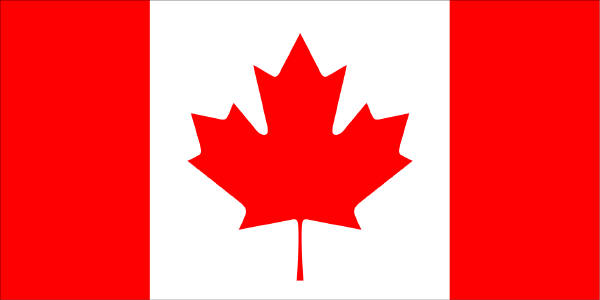
_svg.png)

_svg.png)
TWICE AS FAR
SWISSAIR 111
CRASH INVESTIGATION
![]()
![]()
![]()
- THE INVESTIGATION -
THE RECOVERY PROCESS
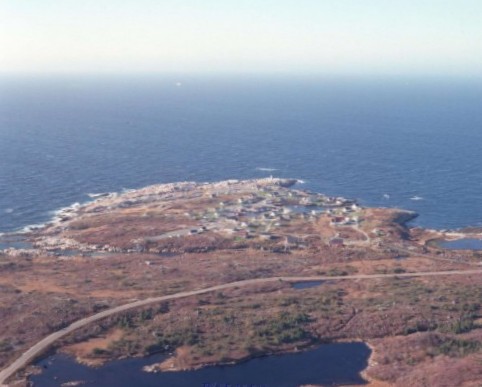
Peggy's Cove taken from the Coast Guard helicopter on Sunday afternoon, the 6th.
This view is to the West-South-West in the general direction of the crash site.
The recovery ships can barely be picked out in this photo.
The weather changes quickly as is normal for this time of the
year in this area of the Atlantic Coast.
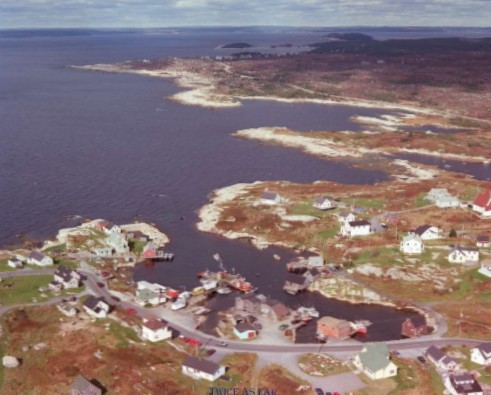
This photo shows Peggy's Cove looking in a
North-Westerly direction towards Whales Back, the present site of one of the
Swissair Flight 111 monuments to the passengers and crew. In the small bay
area at lower centre is the docking area for the contingent of Canadian Coast Guard and RCMP
small boats that patrolled the area for debris during the recovery operation.
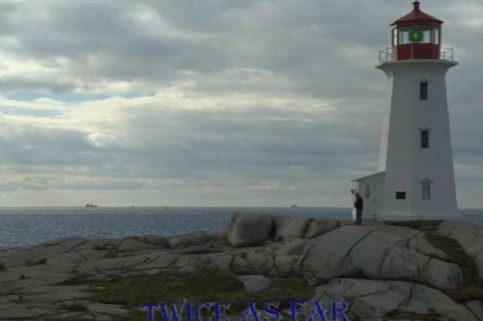
I took this photo on Sunday, the 6th of
September, of the
Peggy's Cove lighthouse right after being dropped off by the helicopter. The people at the lighthouse are looking out to the
crash site about seven kilometres off shore. Four ships of various
sizes can be seen. The HMCS
Preserver is on the left with another ship on the right that is likely a Canadian
Coast Guard vessel. Between them are
two smaller watercraft. The two people, a man and a woman standing side by side
as one, appear to be two lonely sentinels waiting for
the return of those lost in the crash at sea.
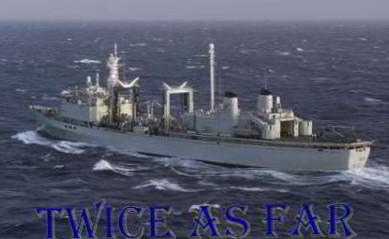
HMCS PRESERVER
The Canadian Navy based at Halifax provided the HMCS Preserver as the command ship for the at-sea operation. Well suited for such a role, during the initial stages human remains and debris were brought aboard from the various search vessels. It was then ferried by helicopter and Coast Guard ship back to the Shearwater Naval Airwing Base where it was all processed.
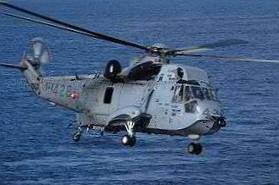
SIKORSKY
CH-124 SEA KING
HELICOPTER
The Sea King was the
unsung hero of the recovery operation, as were the
aircrews and aircraft maintenance
technicians who kept them flying.
THE USS GRAPPLE
(ARS 53)
This photo shows the site of the salvage
effort and is located directly over the crash debris. The large grey ship
at the photo's centre is the USS Grapple (ARS 53), a US Navy Rescue and
Salvage vessel. Beside it is a
Canadian Coast Guard ship, likely the CCGS Earl Grey. The third smaller
ship is unknown. The vessel on the horizon is HMCS Preserver.
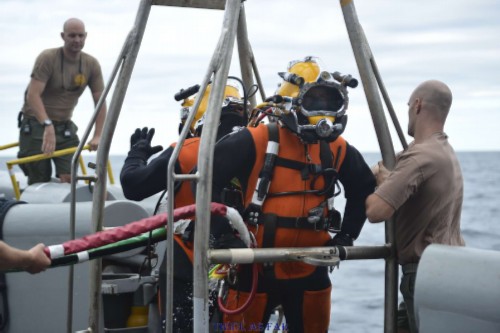
Canadian Navy divers,
soon assisted by US Navy divers, conducted the initial debris and victim retrieval. Within a short period, one of the divers
nearly lost his life when he became entangled in the wreckage. It was
decided to go to the next stage of recovery.
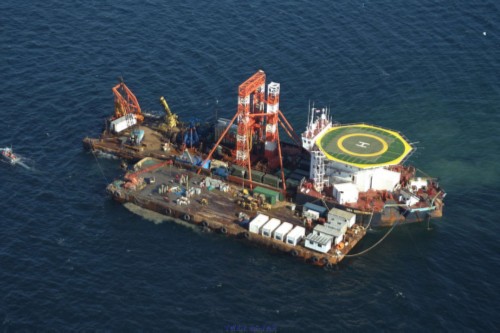
THE SEA SORCERESS
The Sea Sorceress
with its crane and grapple bucket was the next phase of the recovery process.
The barge is alongside the tender with small patrol vessels constantly available
to retrieve any floating debris and to provide transportation to shore if the
need ever arose. As well, the tender's
helicopter pad is visible in the photo.
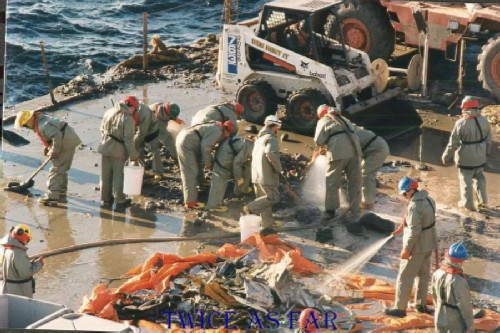
Once the crane brought the material
to the surface, it was dumped on the barge where RCMP, DND, TSB, and others
processed it. Of course, it could be
a mixture of anything from the seafloor along with aircraft debris and human
remains. As can be seen in the photo, it
was processed by raking to sort it
and then washing away the natural seafloor materials. Throughout the
investigation, it would
be asked what evidence of an incendiary device
was found. Many people know how
fragile burnt material can be, and this
process was far from gentle. The
next two procedures to be used were even less gentle on the evidence.
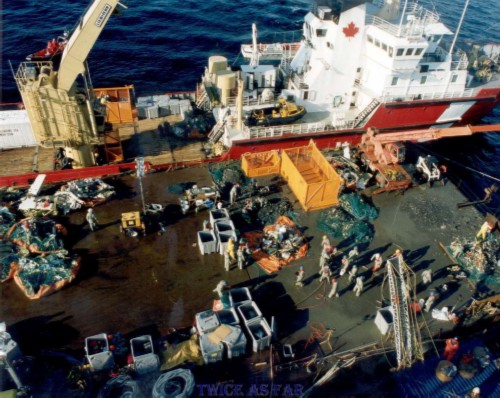
The CCGS Earl Grey is alongside the
barge to collect debris. The ship
was the transport system for the heavy materials that could not
be moved by any other method. The
heaviest items were the three jet engines and the undercarriage pieces, while
some of the wing structures had the greatest surface area.
However, nearly everything else brought to
shore could have fit through a normal doorway in any house.
The grapple bucket was
able to retrieve items even as large as the engines, or as shown
here the undercarriage.
Of course, there could be no one on the
seafloor below to direct placement of the grapple bucket, so the crane
operator's work depended on precise GPS coordination.
Two of the RCMP's newest
patrol vessels were present to assist in the at-sea operation. The
'Simmonds' and the 'Nadon'
were used extensively. This photo
shows the 'Simmonds' in the process of ferrying the barge crew out from their
staging dock.
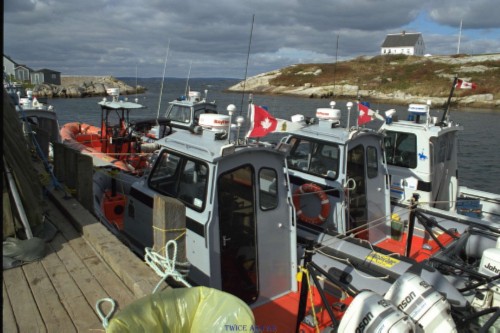
This photo, taken in Peggy's Cove, shows some of the small launches used by both
the CCG and the RCMP for search and recovery, and to act as a safety net for the
barge operations.
Within a couple of days of the crash,
the black boxes were located. Each
has an electronic beacon to help in its location. The Okanagan, one of the
submarines from the Canadian Navy stationed at Halifax,
contributed
in finding them. The two
devices, encased
in an orange metal container to assist in their protection and location,
are shown here mounted in another MD-11 aircraft hopefully to never have to tell
a story.
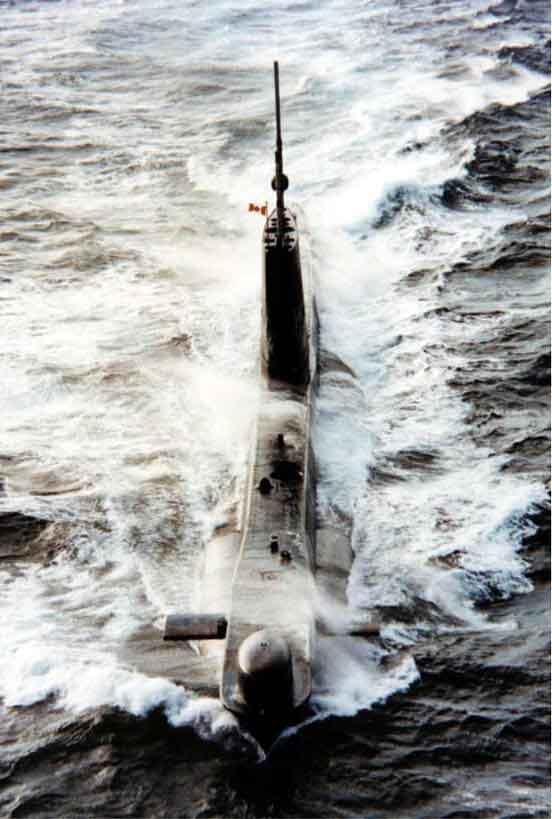
HMCS Okanagan at sea. This submarine was used to find the black boxes from the crash by homing in on the location transmitter from each box.
Not only was the
Canadian Navy and Coast Guard actively involved in the recovery. The
Canadian Army supplied personnel to assist in scouring the shorelines and all
the islands spotted around the St. Margaret Bay area. The primary agency
that coordinated and controlled the ground search was the civilian Nova Scotia
Ground Search and Rescue Agency made up of hundreds of trained volunteers who
provided many thousands of unpaid hours to search hundreds of square
kilometres of beach area. Valuable pieces of debris were retrieved. Of course, during the first
night, the Canadian Air Force with Search
and Rescue helicopters and Hercules aircraft had been involved in the search for
the crash site and the attempted rescue of any survivors.
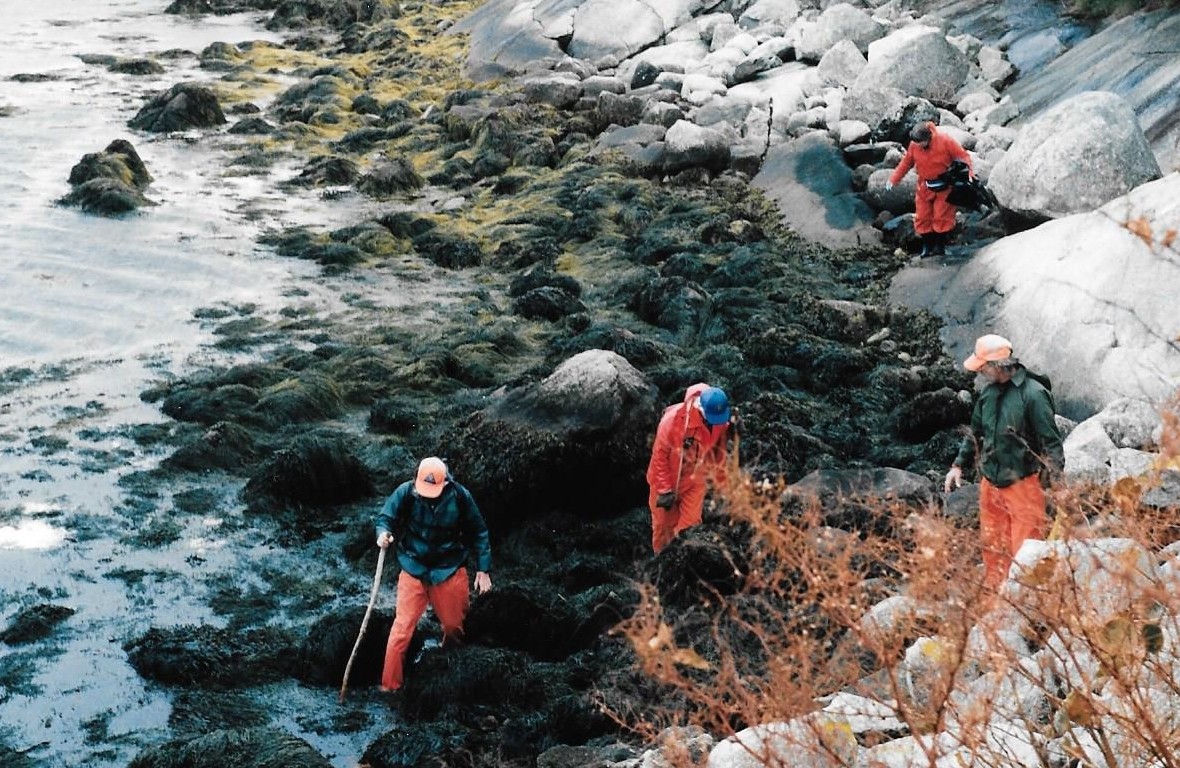
This photo shows four of the Ground Search and Rescue personnel conducting a beach search. It provides a good idea of some of the terrain that they had to traverse. Anyone with any experience with beaches, seaweed, and rocks can appreciate the difficulty that they encountered. Yet the only injuries were three instances of sprained or twisted ankles - a reflection of the level of training they had prior to deployment. 3,141 volunteers from 24 teams based throughout the Province of Nova Scotia provided nearly 49,000 hours of service over the 60 day period that they were deployed.
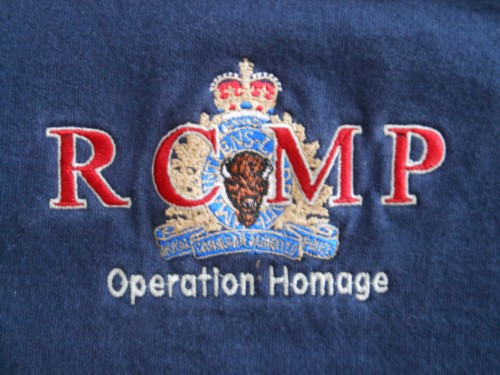
OPERATION HOMAGE
This was the RCMP's official name for the search and recovery operation for the Swissair 111 air crash. This appeared on our shirts as hangar uniform for members of the RCMP's Swissair Task Force.
* * * * * * * * * * * *
| ------------ NEXT PAGE ------------ |
| -------------- SITE MAP -------------- |
| ------------ Home Page ------------ |
![]()
![]()
![]()
![]()